Looking back over 35 years of teaching needlework classes (WOW! That’s a lonnnng time!), from quilting to smocking, heirloom to machine embroidery and more, there is one question that is asked again and again.  “What is the difference between pinstitch and entredeux stitch?” Considering all those years and all those classes, that amounts to a lot of curiosity about hemstitching.
At a cursory glance, the two stitches look very much alike–rows of decorative holes. But they are very different.
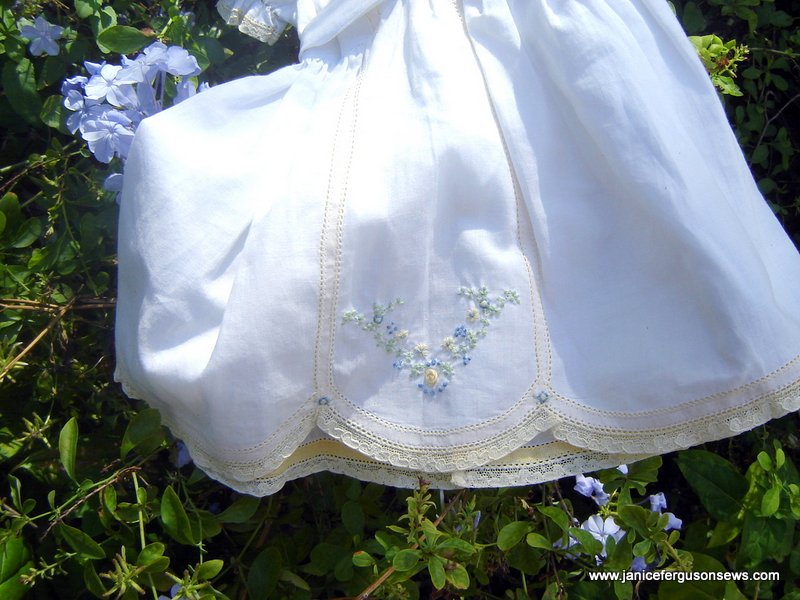
American Girl lace tape dress
This photo shows a doll skirt with pinstitch outlining the U shapes beside and above the yellow lace tape machine made entredeux below below the curves of yellow. The lace tape was stitched in place on the wrong side of the fabric (a machine applique’ technique) and the pinstitch covered the tiny, ho-hum straight stitches which held the lace tape in place.
Below the shadowed, scalloped lace tape was the straight edge of the skirt. Entredeux was worked along the scallops with the left reaches of the stitch pattern catching the edge of the tape. The holes are positioned beside the tape and the opposite reach goes into the fabric below the scallops.
Next, the excess fabric below the lace tape and entredeux was cut away. This left a secure, clean edge against which the yellow lace was butted and then joined with a zig zag.
You cannot cut against pinstitch without it falling apart. Entredeux, on the other hand, offers finished edges on both sides.
Some time ago, a two part tutorial on pinstitch was posted on this blog, followed by requests for a similar post on entredeux. So here it is~~~~~
To my knowledge, entredeux, also known as Venetian hem stitch, is always made by machine, either commercially or by home sewing machines. Some discussion about commercial entredeux follows, to serve as a foundation for the subsequent and main discussion about consumer/homemade entredeux.
COMMERCIALLY MADE ENTREDEUX: In case you are new to heirloom sewing and goods, entredeux is a ladder like trim whose name in French means “between {entre} two {deux}. Except for some really raggedy domestic-made entredeux, it is made in Switzerland.  Most commonly used between two pieces of lace, lace and fabric or fabric and fabric, it is uncommonly used in various other creative ways. Entredeux is available in white, ecru, ivory, black, pink and blue, is sold by the yard and looks like this:
There are many variations on this basic style, from double or triple rows of holes to alternating large and small holes, and more. NOTE: All entredeux photos are from Farmhouse Fabrics, my all-time favorite mail order source for sewing supplies. Entredeux prices range from $1.90 – $4.75 per yard.
They all come with fabric on either side of the “railroad tracks for ants” and that fabric is there for ease in handling and for attachment techniques. Almost always, the fabric is cut away and only the holes remain. They add not only decorative interest between two rows of lace but also strength between fabric and lace at a neckline or between fabric and fabric in the armscye or shoulder seam. In my humble opinion, consumer made entredeux is rarely strong enough or suitable for these two uses.
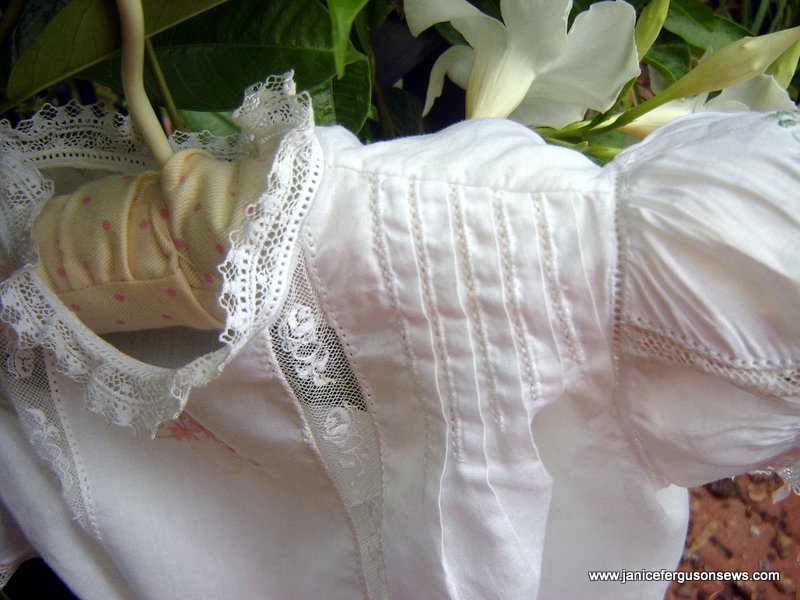
commercial entredeux at neckline and armscye, pinstitch over tucks on first grandchild’s birthday dress
CONSUMER MADE ENTREDEUX:Â This discussion/tutorial deals only with making entredeux on home sewing machines which have a stitch for this.
For those readers without this specific stitch, Carol Ahles gives instructions for creating rather credible entredeux using other stitches on a number of machines.
Her book, Fine Machine Sewing is an encyclopedia of techniques with clear, detailed directions and photos. I highly recommend it.
So let’s assume that you have an entredeux stitch on your machine and you want to make entredeux. To be successful, you will need some very specific materials:
- machine stitch–select basic Venetian hemstitch for entredeux (see diagram above). After some practice, you might enjoy trying out some of the other hemstitches available on your machine.
- presser foot–open toe is best for visibility. But if there is any puckering, a metal foot holds the fabric more firmly and might give better results.
- very fine thread, preferably 1) Madeira Cotona 80/2, or 2) Mettler 60/2 (kelly green band atop spool), or as a last resort 3) DMC 50/2 machine embroidery thread
- spray starch
- optional: stabilizer
fabric selection–The first consideration is fabric. I have made entredeux on various weights of 100% cotton batiste, cotton organdy, linen and wool.
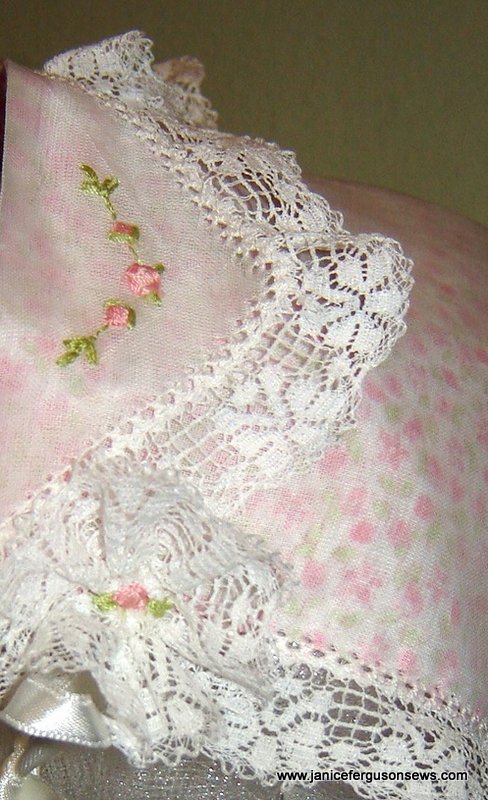
Entredeux stitch was worked on this zig zag bonnet through a single layer of organdy around brim below the embroidery. It was also stitched through the double layer of organdy and lawn print lining around the sides and back of this bonnet .
Multiple tries on blends have rarely rendered anything but frustration, disappointment and ruined fabric.
Occasionally but rarely, I was satisfied with entredeux made on the crosswise grain of a polyblend fabric, but it puckered horribly on the straight of grain. It just wasn’t worth the effort. Just like the impossibility of making a silk purse from a sow’s ear, you can’t get nice entredeux on 99% of all fabric blends.
To prepare the fabric, it is best to pre-wash and then press between multiple applications of spray starch. Crisp, stiff fabric works best.
needle selection–Select a needle whose size is appropriate for your project. The #120 wing makes a hole comparable to the size in standard commercial entredeux. For baby or doll clothes, I prefer the #100 sharp/universal which produces holes more like the commercial baby entredeux. Of course, always rehearse your needle and your stitch settings for best results.
entredeux stitch–On the Brother ULT series (2001, 2002D and 2003D), Duetta (4000D or 4500D) and Quattro (6000D or 6700D), the entredeux stitch is #3-08. It can be found in the utility stitch menu, the third tab on the right hand column, which shows a feather stitch. It may also be on other Brother models but I am unfamiliar with them. Babylock machines, I believe, have the same stitch in the same location. Viking and Pfaff have nice entredeux but I am not familiar with other machines.
adjusting the stitch–It seems that men must have selected the default settings, because they are very bulky and masculine. My Brother Quattro entredeux comes up with W. 5.0 and L. 3.5 with tension 4.0. It looks like this:
NOTE: All stitched samples are worked with Madeira Cotona 80/2. Depending on the fabric, I am most satisfied with settings between W. 3.0 and L 3.0 (my standard linen setting) and W. 2.5 L 2.5 (for batiste). If there is any pucking, I reduce the needle thread tension.
fine thread–my preferred thread is Madeira Cotona 80/2. This is most readily available in white and ecru, but now can be purchased in a broad array of colors at Farmhouse Fabrics.  Sally (at Farmhouse) also carries DMC 50/2 machine embroidery thread and YLI 70 wt. heirloom thread which I have used when I need a color that is not available in Madeira.
Making entredeux in colored thread can add a unique design element. On the Liberty Goat dress, I used burgundy lace tape as a foundation for entredeux and needed matching thread. There was no Madeira Cotona 80/2 in that color. So I used either DMC or Mettler, I just can’t remember, but I was satisfied with the result. I could have used a pinstitch, but I wanted the stronger color that came from more threads (due to more stitches in each repeat) with entredeux.
 spray starch–It’s likely any spray starch will work, but I use the regular Niagra, not professional. Spraying the fabric lightly and allowing 15-30 seconds for the starch to penetrate the fibers works well Press and then repeat this process until the fabric is very stiff.
stabilizer–Occasionally, with very shifty fabrics, starch does not stabilize well enough. In those instances, 3″ wide Stitch & Ditch stabilizer can make the fabric behave. Others use water soluble stabilizer with success.
TIPS FOR ACTUALLYÂ MAKING ENTREDEUX–
added 1/2″ waste–When stitching entredeux along a sleeve or hem edge, it is important to leave approximately 1/2″ excess along the edge to cut away. Any less than that will make it difficult for the feed dogs to move the fabric as precisely as necessary. It is also very difficult to trim away the necessary excess if it is any narrower than that. This consideration needs to be to factored in when you decide where to stitch the entredeux.
corded entredeux–With some practice, you might want to try cording the stitch for a look more like that of commercial entredeux.
Gimp is a good choice for the cording but perle cotton is another popular option.
Guiding the gimp or perle cotton is most easily done with a cording foot, but it must offer gimp placement precisely outside the width of the wing needle. I don’t yet have a cording foot for my Brother Quattro so I simply guided it carefully and slowly for this sample. On earlier machines with a cording foot, I was able to guide the cording easily and stitch faster.
seamline entredeux–Making entredeux along a seamline, such as the shoulder seam, is a nice heirloom touch. On my granddaughter’s Easter dress a few years ago, this feature was added.
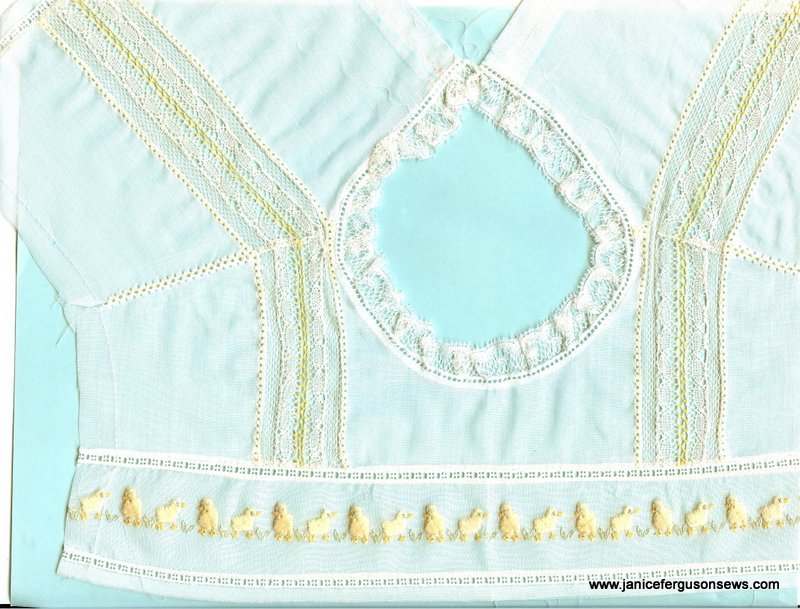
Consumer machine made entredeux was stitched over the shoulder seam. Note that commercial entredeux was used at the neckline for the extra strength needed for an active child’s garment. Note also that the entredeux is stitched with yellow yellow 80 wt. Madeira Cotona thread. This is the yoke to my granddaughter’s Easter dress.
This is not difficult. You simply sew the shoulder with a 1/2″ seam allowance, press the seam open and then stitch down the center with the needle penetrating in the “ditch” of the seamline. After pressing, you trim away the excess fabric.
beading/gathered entredeux–Entredeux can be made over gathers on fine fabrics. When I do this, I always use Stitch & Ditch stabilizer. This technique made perfect beading for an American Girl doll dress I made several years ago.
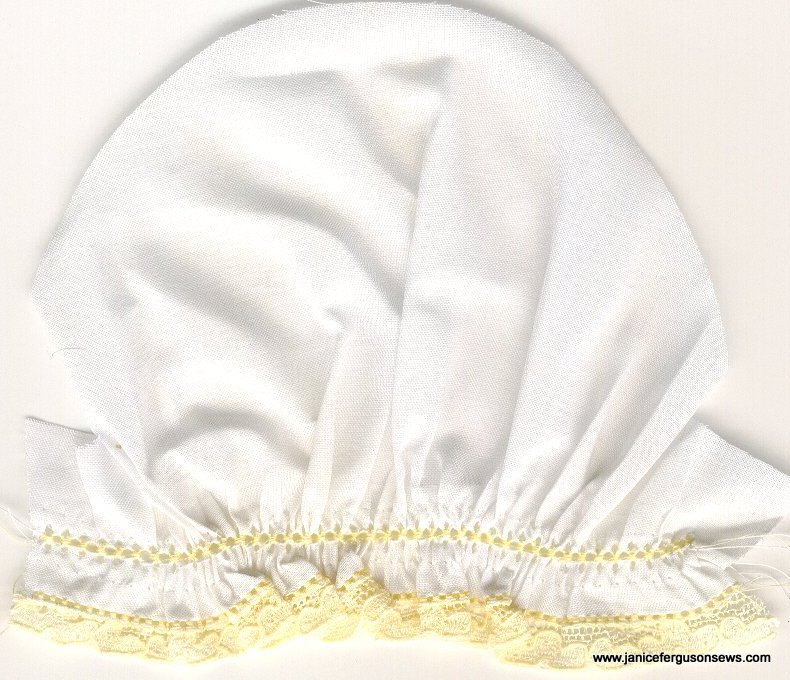
Wing needle entredeux is stitched over 11″ sleeve gathered to 5 1/2″. Entredeux is also stitched along the sleeve edge. The 1/2″ excess fabric was trimmed away and then the lace was butted to the entredeux and joined with a zig zag.
Entredeux is also stitched along the sleeve edge. The 1/2″ excess fabric was trimmed away and then the lace was butted to the entredeux and joined with a zig zag.
In most situations where I join lace to a raw edge like this sleeve, I would use pinstitch. But this is very dense and very narrow. A wing or even #100 needle would have punched visible, perhaps damaging holes, and “eaten up” some of the 3/8″ lace. By using the entredeux stitch, a #60 needle with 80 wt. thread joined the lace to the entredeux with a tiny zig zag.
When the dress was completed, the entredeux was threaded with 1/8″ silk ribbon. Can’t you just see baby daygown sleeves gathered like this?
decorative stitching with entredeux–Sometimes, the entredeux stitch is just the touch you need. I especially like it for bird, butterfly or bee flight patterns.
The bees’ flight pattern are made with a black entredeux stitch woven with metallic thread. There is no special need for a wing needle, just one which makes a hole large enough to accommodate a threaded needle passing through. This pincushion was a class project I taught in Huntsville.
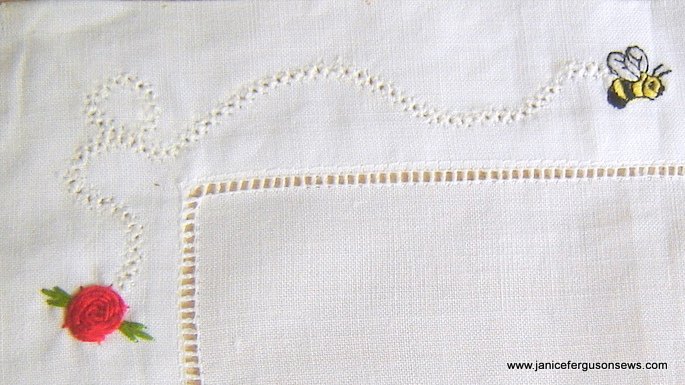
embroidered corner of a commercially made linen placemat
This post is already way too long, so I will close with my wishes for you all to have success and fun with this very, very useful and versatile stitch. Let me know if you have any questions.

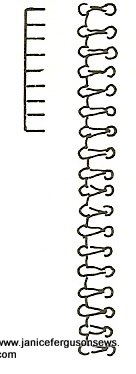
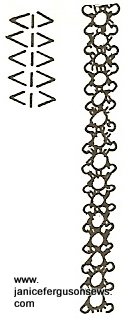




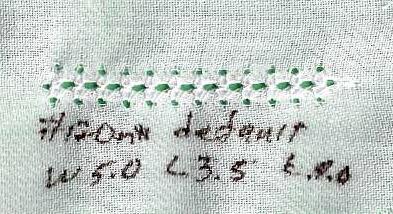

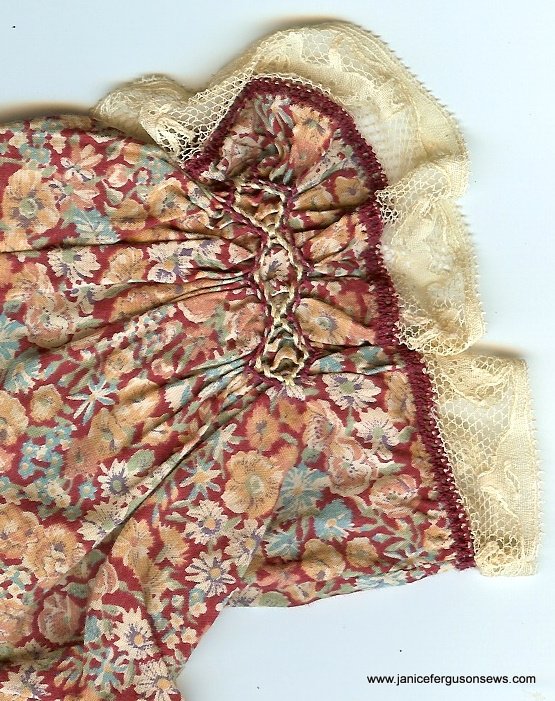
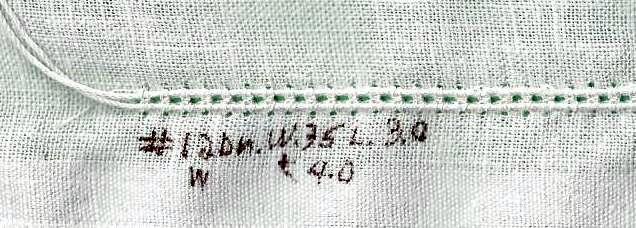
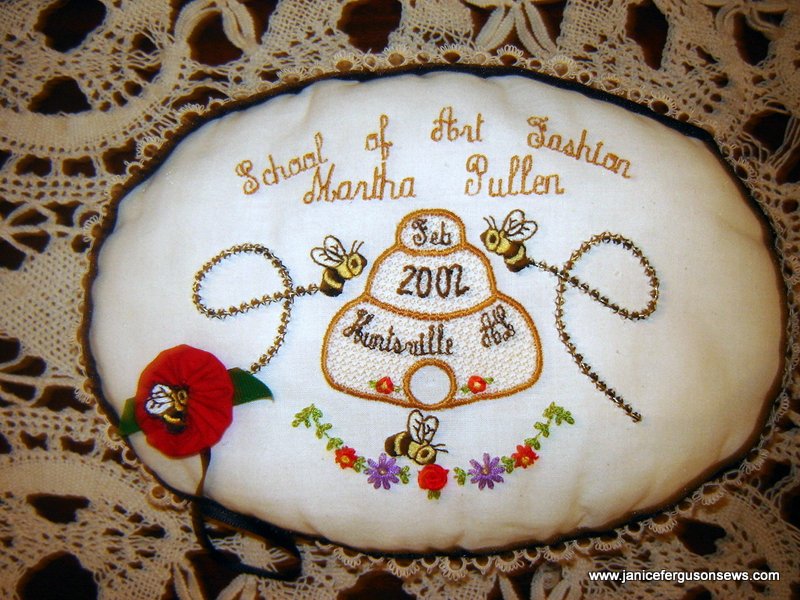

30 responses to “Tutorial: Consumer-made Entredeux”